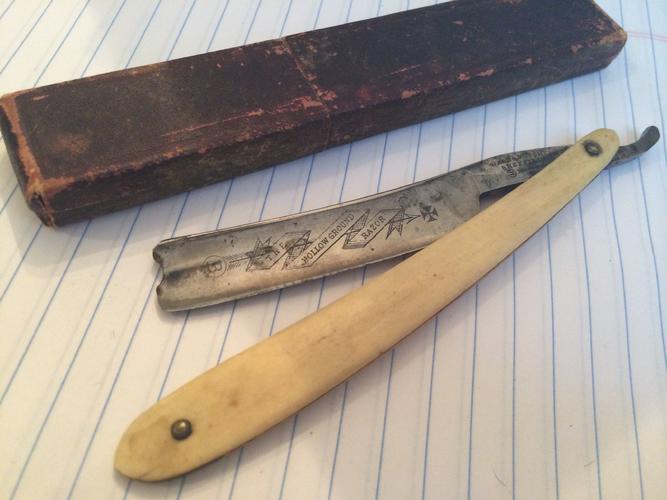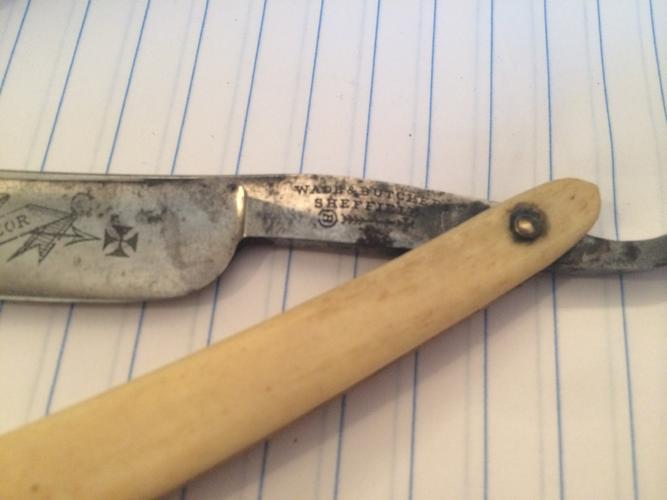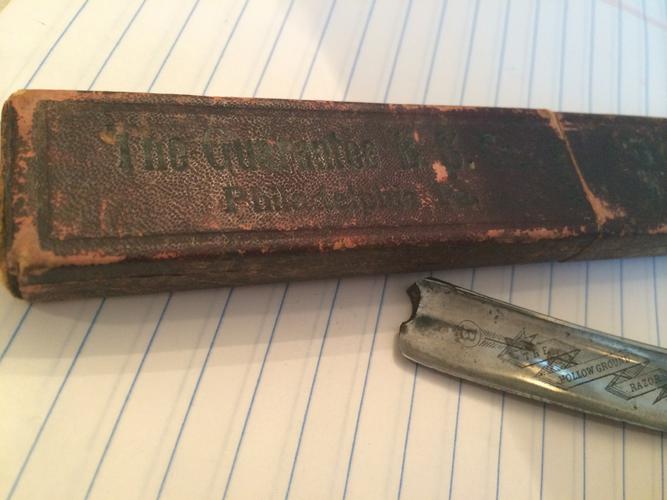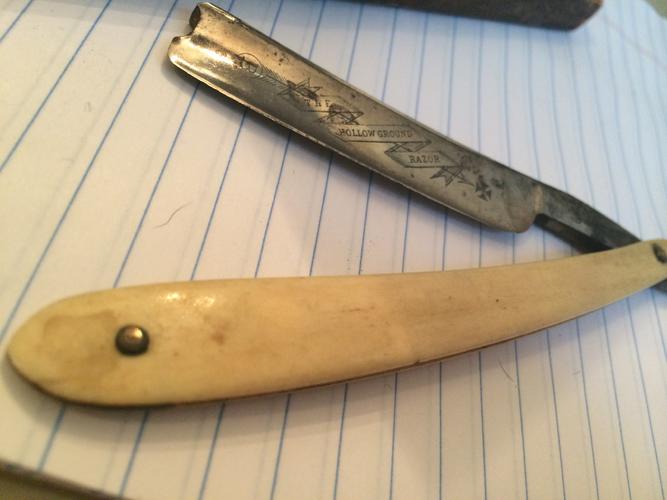Results 11 to 20 of 32
Thread: wade and butcher question..
-
03-24-2010, 08:56 PM #11Junior Member

- Join Date
- Feb 2010
- Location
- San Diego, CA
- Posts
- 15
Thanked: 2
Jimmy! Brilliant!
a bit more looking around on what exactly ebonite/vulcanite is (just hard rubber, 'vulcanized' apparently) and I'm thinking that's exactly what they are. some other pictures I've found of how it looks when it oxidizes and specifically the fact that one of the pictures said it had only happened under a bath of very hot water - that has to be it, because they sure don't smell like celluloid (another smell quite accustomed to, due to my employment in the 'R&D' dept of a major manufacturer of guitars).
thanks!!
-
03-24-2010, 11:14 PM #12

In all honesty I can not say I have ever seen genuine tortoise scales on a razor; however, I understand they tend to turn dark all over as they age. Do you think that is a possability?
-
03-25-2010, 03:25 AM #13Member

- Join Date
- Nov 2009
- Posts
- 43
Thanked: 6
-
03-25-2010, 04:11 AM #14Professional Pedantic Pontificator

- Join Date
- Apr 2009
- Location
- Monmouth, OR - USA
- Posts
- 1,163
Thanked: 317
I'm pretty well out of my pipe collecting days, but I agree 100%. That looks just like an old vulcanite pipe stem.
IF it really is vulcanite, you cane actually get rid of the oxidation and shine it up really nicely.
PROCEED WITH CAUTION! FOLLOW THESE STEPS AT YOUR OWN RISK!
If they turn out to be something other than vulcanite, these directions will probably destroy them. As always, if you're going to do any serious restoration to the scales, the razor should be disassembled first.
Washing the scales with bleach and water will remove the oxidation very easily. If it's deep, you may have to soak them in bleach and water. Be very VERY careful doing this, because extended exposure will badly soften, and eventually destroy the material.
If you're going to wash them with, a 50/50 solution of bleach and water will do. Rinse REALLY well. They will feel slimy as you rinse the bleach off, and it's critical that you keep rinsing with fresh water until they stop feeling slimey.
If that doesn't cut it, you can soak them in 1:4 or 1:8 bleach and water. Check them every 15 minutes at the longest. 5 is often enough. When they have soaked enough, you should be able to scrub off all the oxidation with a paper towel. Again, if you forget they are soaking and fall asleep on the couch, you'll wake up to find that the scales have been replaced by an unidentifiable slimey squigly thing.
Once you've got all (or most) of the oxidation gone, you will need to polish them up, or they'll oxidize again VERY quickly. Under no circumstances should you use any form of power tool to polish them unless you've been working with vulcanite for a long time. I used to do pipe restos for people, and probably half the pipes I got had been badly damaged by somebody with a dremel. FYI: I to almost everything with a dremel when I'm working on a razor, and I still say not to use one on vulcanite.
There are many products for polishing plastic and rubber. Personally, I like to use denicare mouthpiece polish. It's available at a variety of pipe shops and music stores. (Works nicely on plastic, vulcanite and acrylic used in woodwind mouthpieces. It also works well on celluloid.) Just get some on your fingers and start hand polishing. If it starts to get hot under your fingers, stop. Vulcanite, especially old vulcanite, can get soft if it get's too warm. Very old vulcanite will soften at temperatures that won't even burn your fingers.
They will also need to be sealed. It doesn't take much. Denicare contains wax and grease in addition to a mild abrasive, so it seals while you polish. If you use something else to polish, you'll want to seal them. A hard wax like carnuba works best, but paraffin will do. However, you still have to be very careful about heat, so it's usually safest to rub them with a block of room temperature wax, and then buff the wax off by hand using a soft cloth.
-
03-25-2010, 07:10 AM #15Junior Member

- Join Date
- Feb 2010
- Location
- San Diego, CA
- Posts
- 15
Thanked: 2
thanks, steve!
I've already got most of the oxidation off with some elbow grease and some 800 and 1000 grit wetordry but I know just the place where I should be able to find denicare - excellent tip!
by the way, to the tortoise question - once I got a little more into it with the sanding I noticed the smell is most definitely 'old rubber'..the heat must have made it a little different smelling somehow when the steam hit it (which is what caused the oxidation in the first place). but a good suggestion, none-the-less, that I hadn't even thought of!
-
03-25-2010, 08:50 AM #16Professional Pedantic Pontificator

- Join Date
- Apr 2009
- Location
- Monmouth, OR - USA
- Posts
- 1,163
Thanked: 317
A side note on denicare, it can feel a little gritty under your fingers, but the abrasive is very soft, so the larger grits just crumble up as soon as you start using it. It's actually VERY mild stuff.
Also, I didn't realize the oxidation had just shown up when recently exposed to steam. In that case, you would probably have skipped the sanding AND skipped the bleach, and gone straight for the denicare. I've never used sandpaper on vulcanite, so I'm not sure if you'll need to do something to buff out sanding marks before the polish or not.
-
03-25-2010, 05:12 PM #17Junior Member

- Join Date
- Feb 2010
- Location
- San Diego, CA
- Posts
- 15
Thanked: 2
good to know, steve - I'll have to keep that in mind for next time..haha
I'll probably just go the rest of the way with Micro-Mesh and just use the denicare to seal the material.
-
09-07-2014, 10:20 PM #18

Gunna bump an old thread again, found another one today and once again only found a picture - no details after researching.
Wade & Butcher
Sheffield
"The HollowGround Razor"




Any info would be great! Thnx guys!www.rzrrestoration.com
Interested in Japanese Blades & Wade&Butcher razors
-
09-07-2014, 10:45 PM #19
 Be careful how you treat people on your way up, you may meet them again on your way back down.
Be careful how you treat people on your way up, you may meet them again on your way back down.
-
09-07-2014, 10:56 PM #20


 2Likes
2Likes LinkBack URL
LinkBack URL About LinkBacks
About LinkBacks






 Reply With Quote
Reply With Quote



